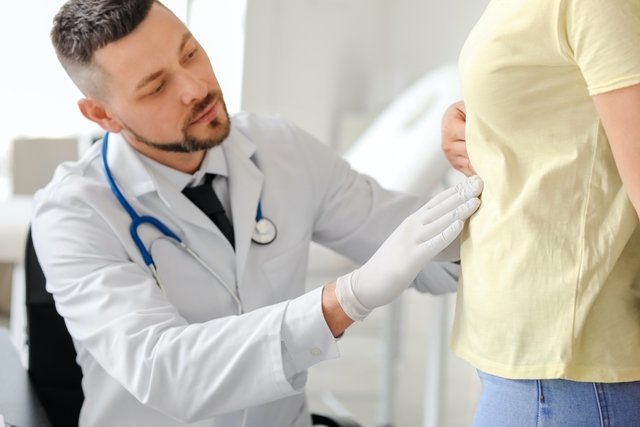Fat in the liver, or hepatic steatosis, is when there is an accumulation of fat in the liver cells, impairing the functioning of the organ and causing symptoms such as pain in the right side of the abdomen, swollen belly, nausea, vomiting or general malaise.
The accumulation of fat in the liver is related to unhealthy lifestyle habits, such as having a diet rich in fat and carbohydrates, a sedentary lifestyle and excessive alcohol consumption, but it can also occur due to high cholesterol, obesity, pregnancy or diabetes, for example .
In most cases, as the accumulation of fat in the liver does not cause initial symptoms, the condition ends up being discovered during routine exams, and its treatment must be carried out under the guidance of a gastroenterologist or hepatologist, which generally involves changes in lifestyle habits, diet or use of medicines.

Fatty liver symptoms
The main symptoms of fatty liver are:
- Pain in the upper right side of the belly;
- Swollen belly;
- Unexplained weight loss;
- Constant tiredness;
- General malaise;
- Constant headache;
- Nausea or vomiting.
The accumulation of fat in the liver is usually silent, and may not cause symptoms or may only cause fatigue or mild pain in the abdomen.
However, as fat deposits in the liver and is not treated, it can cause inflammation or scarring of the liver, interfering with its function, leading to symptoms. Learn about other symptoms of fatty liver.
Furthermore, in more serious cases of fatty liver, complications such as cirrhosis or liver failure may arise, with symptoms such as whitish stools, yellowish skin and eyes, very dark urine or itching all over the body, for example.
Online symptom test
If you think you may have fatty liver, please select your symptoms to find out your risk:
How to confirm the diagnosis
The diagnosis of fatty liver is made by a hepatologist or gastroenterologist, through the evaluation of symptoms, lifestyle habits and health history. In addition, blood tests may be ordered that measure blood clotting time and liver enzymes, such as ALT and AST, GGT, alkaline phosphatase and bilirubin.
Taking care of your health has never been easier!
If a person has elevated liver enzymes or a family history of cirrhosis, the doctor may also order other blood tests, such as antinuclear antibodies, smooth muscle antibodies, a1-antitrypsin, ceruloplasmin and thyroid-stimulating hormone (TSH) levels.
Other tests that the doctor may order are abdominal ultrasound, computed tomography or magnetic resonance imaging, as well as a liver biopsy to check why this organ is not working. See the main tests that evaluate liver function.
Possible causes
The causes of fatty liver are not yet well understood, however, it is believed that it is related to genetic, nutritional and environmental factors, resulting in an imbalance between the consumption and synthesis of fat by the body and its use and elimination.
Thus, the main factors that cause fat accumulation in the liver are:
- Excessive or constant consumption of alcoholic beverages;
- Food rich in fats and sugar;
- Family history of liver problems;
- Obesity;
- Type 2 diabetes or insulin resistance;
- High pressure;
- High cholesterol and/or triglycerides;
- Age over 50 years;
- Pregnancy;
- Sedentary lifestyle;
- Smoking habit;
- Hypothyroidism;
- Total parenteral nutrition;
- Severe malnutrition;
- Metabolic diseases such as glycogen storage disorders or homocystinuria;
- Wilson’s disease.
Furthermore, another factor that contributes to the accumulation of fat in the liver is the use of medications, such as corticosteroids, tamoxifen, amiodarone or methotrexate, for example. Learn about other causes of fatty liver.
How the treatment is carried out
The treatment of fatty liver must be carried out under the guidance of a gastroenterologist or hepatologist, who may indicate:
1. Changes in lifestyle habits
Changes in lifestyle habits that may be recommended by your doctor to treat fatty liver include avoiding alcohol consumption, practicing at least 30 minutes of physical exercise per day and losing weight. Check out other tips for treating fatty liver.
These changes are important factors in helping to eliminate fat in the liver, as they increase metabolism and fat burning, helping to control weight.
2. Diet changes
Changes in diet are fundamental for the treatment of fatty liver, and the doctor generally recommends reducing the consumption of foods rich in fat or sugar, such as yellow cheese, bacon, beef sirloin, chicken skin, pork, chocolate, butter, margarine, ice cream, sweets or fruit juice. See other foods that should be avoided.
Furthermore, the doctor should recommend a specific diet for fatty liver, which should preferably be guided by a nutritionist, who may recommend increasing the consumption of foods such as fresh and natural fruits, fresh vegetables and whole grains rich in fiber.
Watch the following video with nutritionist Tatiana Zanin with tips for following a fatty liver diet:
3. Medicines
Medicines for fatty liver must be prescribed by a doctor to control diseases that impair its function, as there are no specific medicines for this disease. In this way, the following can be indicated:
- Statinssuch as simvastatin or rosuvastatin, to help lower high cholesterol;
- Antidiabeticssuch as metformin, liraglutide or insulin, to control diabetes;
- Thyroid medicinesuch as levothyroxine;
- Liver protectorssuch as ursodeoxycholic acid.
Furthermore, the doctor may recommend treatment with vitamin E, which has a powerful antioxidant action and can help reduce or neutralize the damage caused by inflammation in the liver. See other remedy options for fatty liver.

Sign up for our newsletter and stay up to date with exclusive news
that can transform your routine!
Warning: Undefined array key "title" in /home/storelat/public_html/wp-content/plugins/link-whisper-premium/templates/frontend/related-posts.php on line 12
Warning: Undefined array key "title_tag" in /home/storelat/public_html/wp-content/plugins/link-whisper-premium/templates/frontend/related-posts.php on line 13



